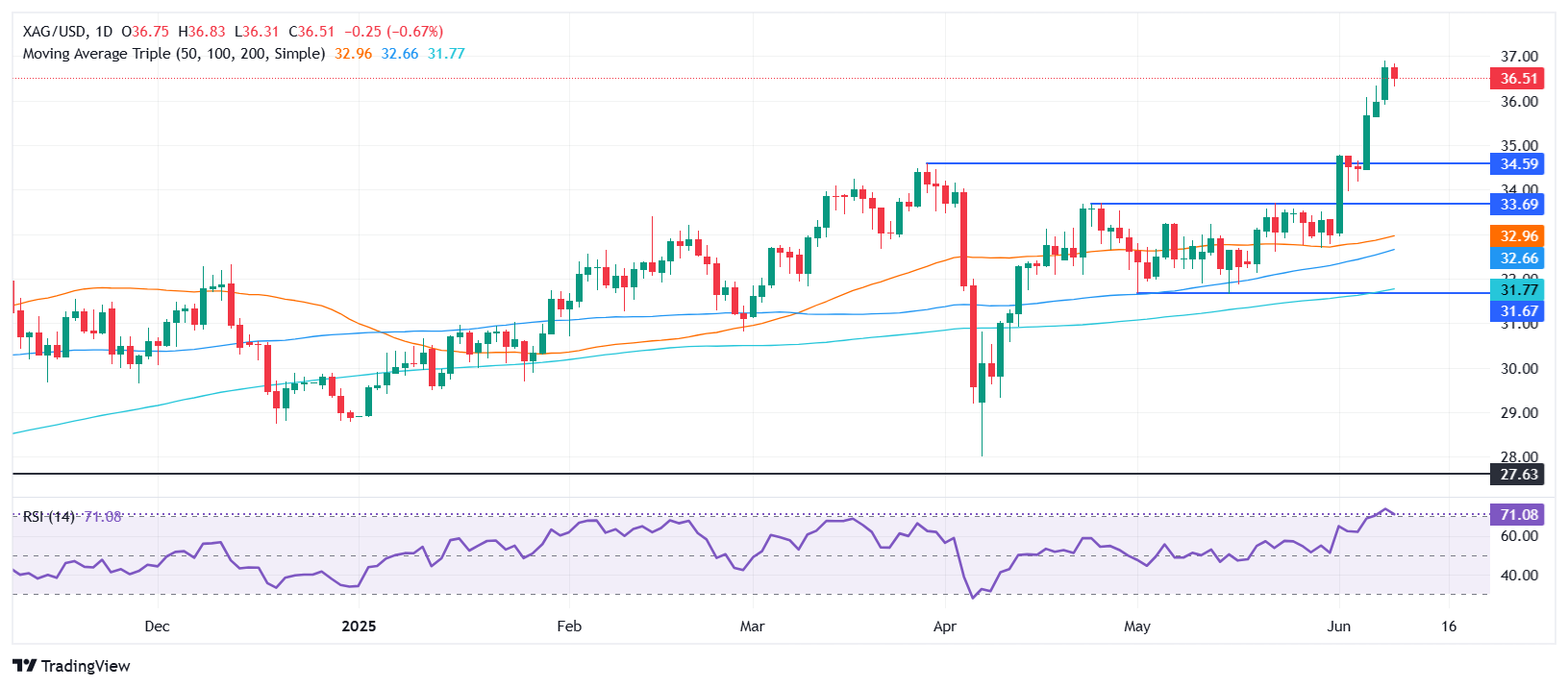Silver Price Forecast: XAG/USD pulls back from $37.00 as US Dollar rebounds on US-Sino talks
- Silver slips to $36.52 after briefly testing $37.00 resistance zone.
- RSI signals overbought conditions, hinting at potential near-term pullback.
- Uptrend intact above $35.00; key support seen at $35.40 and $35.00.
Silver price faces resistance near $37.00 and retreats by some 0.50% on Tuesday as the US dollar stages a comeback, with investors growing more confident of a US-China deal later in the day. At the time of writing, the XAG/USD trades at $36.52, below its opening price.
XAG/USD Price Forecast: Technical outlook
Despite retreating, XAG/USD remains upward biased after clearing the October 23, 2024, peak of $34.86, which exacerbated an advance to $35.00 and beyond. It should be noted that the Relative Strength Index (RSI) reached overbought conditions.
Although this sets up a pullback, buyers would remain safe as long as Silver remains above the $35.00 mark. Key resistance lies at $36.82, $37.00, and $37.49, a 13-year high set on February 29.
Conversely, if XAG/USD tumbles below $36.00, the first support would the $35.40, a high from October 2012, which has since turned into support. Once surpassed, the next stop is $35.00, followed by the $34.00 and $33.00 figures, ahead of the 50-day Simple Moving Average (SMA) at $32.95.
XAG/USD Price Forecast: Technical outlook

Silver FAQs
Silver is a precious metal highly traded among investors. It has been historically used as a store of value and a medium of exchange. Although less popular than Gold, traders may turn to Silver to diversify their investment portfolio, for its intrinsic value or as a potential hedge during high-inflation periods. Investors can buy physical Silver, in coins or in bars, or trade it through vehicles such as Exchange Traded Funds, which track its price on international markets.
Silver prices can move due to a wide range of factors. Geopolitical instability or fears of a deep recession can make Silver price escalate due to its safe-haven status, although to a lesser extent than Gold's. As a yieldless asset, Silver tends to rise with lower interest rates. Its moves also depend on how the US Dollar (USD) behaves as the asset is priced in dollars (XAG/USD). A strong Dollar tends to keep the price of Silver at bay, whereas a weaker Dollar is likely to propel prices up. Other factors such as investment demand, mining supply – Silver is much more abundant than Gold – and recycling rates can also affect prices.
Silver is widely used in industry, particularly in sectors such as electronics or solar energy, as it has one of the highest electric conductivity of all metals – more than Copper and Gold. A surge in demand can increase prices, while a decline tends to lower them. Dynamics in the US, Chinese and Indian economies can also contribute to price swings: for the US and particularly China, their big industrial sectors use Silver in various processes; in India, consumers’ demand for the precious metal for jewellery also plays a key role in setting prices.
Silver prices tend to follow Gold's moves. When Gold prices rise, Silver typically follows suit, as their status as safe-haven assets is similar. The Gold/Silver ratio, which shows the number of ounces of Silver needed to equal the value of one ounce of Gold, may help to determine the relative valuation between both metals. Some investors may consider a high ratio as an indicator that Silver is undervalued, or Gold is overvalued. On the contrary, a low ratio might suggest that Gold is undervalued relative to Silver.



